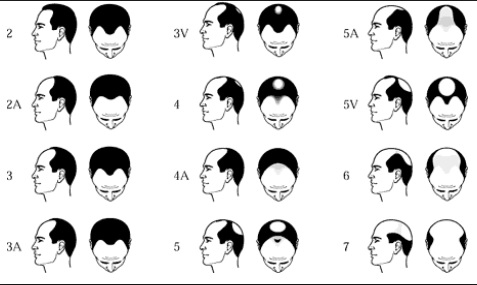What Is Telogen Effluvium
In order to understand what telogen effluvium is, it is first necessary to be aware of the three stages which characterize the hair’s life cycle.
(1) anagen – active growth phase
(2) categen – transitional phase when hair growth slows
(3) telogen – when hair is in a resting phase and stops growing altogether
Each hair follicle has a different life cycle. This is why we do not lose all of our hair at the same time. Between 80-90% of our hair is in the growth phase.. The rest are in the telogen resting phase or transitioning to this stage.
However, there are a number of different factors which can disrupt this balance, causing a much higher number of hairs to enter telogen. Hair will then fall out about two to three months later. Treatment will depend on pinpointing the causes.
Hair Loss From Pattern Baldness
In telogen effluvium, hair usually tends to shed somewhat diffusely and sporadically. However, in pattern baldness, hair loss occurs in progressive stages. These tend to have consistent and distinct appearances. This is illustrated on the Hamilton Norwood scale of baldness for men and women.
In men, hair will start to shed in the hairline. Eventually, the crown will also become bald. Over time , hair loss will affect the entire top of the head, except a wreath along the back and sides.

In women, there is usually a linear section(hair parting) on the side of the scalp which starts to show an increasingly larger area of the scalp.
Finding the Right Treatment For Hair Loss
When hair first starts to fall out prolifically, it is often too soon for an average person to know if they are suffering from pattern baldness or telogen effluvium. However, a doctor can help make this determination.
While androgenic alopecia is due to genetics, telogen effluvium can be caused by different factors
(1) stress from a surgical operation
(2) nutritional deficiencies
(3) thyroid or other type of hormonal imbalance
(4) side effects from medication
(5) life circumstances (e.g. divorce, work related stress )
(6) crash diets or other sudden changes in one’s sleeping or eating patterns.
Minoxidil can help strengthen the follicles state of overall health when it comes to employing a treatment for hair loss.
However, drug intervention will only be a temporary fix for telogen effluvium until the actual cause is addressed. More often than not, this is the most reliable way to reverse the condition. The processes for producing new shafts are usually not permanently impacted.
http://www.webmd.com/skin-problems-and-treatments/hair-loss/hair-loss-women-14/natural-treatments-for-hair-lossAdditional resource
